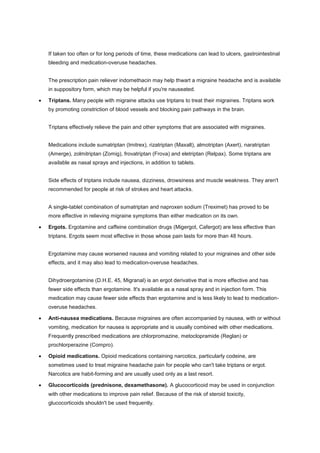Migraine is a neurological disease characterized by recurrent moderate to severe headaches often accompanied by sensitivity to light and sound. Migraines typically involve four stages - prodrome, aura, headache, and postdrome - and are caused by changes in brain chemicals and blood vessels in the brain. Common triggers include hormonal changes, foods, drinks, stress, sensory stimuli, and medications. Treatment involves both acute pain medications to stop an attack and preventive medications to reduce frequency and severity.
![[MIGRAINE]
DEFINITION-:
Migraine is a chronic neurological disease characterized by recurrent
moderate to severe headaches often in association with a number
of autonomic nervous system symptoms. The word derives from
the Greek ἡμικρανία (hemikrania), "pain on one side of the head",[1]
from
ἡμι- (hemi-), "half", and κρανίον (kranion), "skull"
1. A migraine headache can cause intense throbbing or a
pulsing sensation in one area of the head and is
commonly accompanied by nausea, vomiting, and
extreme sensitivity to light and sound.
2. Migraine attacks can cause significant pain for hours to
days and be so severe that all you can think about is
finding a dark, quiet place to lie down.
3. Some migraines are preceded or accompanied by sensory
warning symptoms (aura), such as flashes of light, blind
spots, or tingling in your arm or leg.
4. Medications can help reduce the frequency and severity of
migraines. If treatment hasn't worked for you in the past,
talk to your doctor about trying a different migraine
headache medication. .](https://image.slidesharecdn.com/migraine-141219000941-conversion-gate01/85/Migraine-1-320.jpg)







